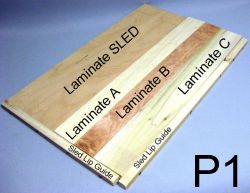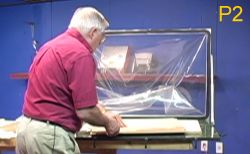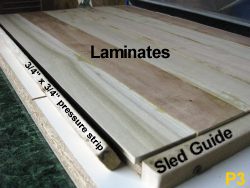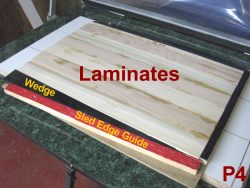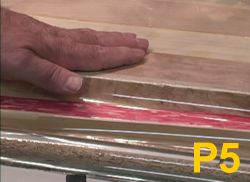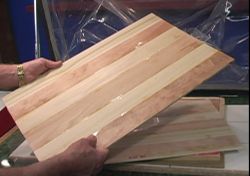
Edge Gluing -
For panels and decorative flooring

Edge Gluing Techniques #6
Video that accompanies this article can be found here
Edge gluing thin slats for panels and decorative flooring.
Edge gluing is used in such applications as decorative floor edging or panel making and can be done in a vacuum press with high quality results. Two key factors will affect the quality of the end piece; the straightness of the edges and uniform thickness of your slats. If the slats have a slight curl, the pressure from 1800 lbs/sq.ft. will normally flatten them with out any problem.
There are two methods to provide the side pressure necessary to get good edge glued joints. Both require a "sled" to hold the material (P1). The base is just plywood or MDF and a 90 degree corner is attached to one side and one end. The height of this right angle is about 1/8" less than the thickness of your finished piece. All the edges are rounded over to avoid a sharp edge that could puncture the bag.You want to coat the sled so that glue squeeze out does not stick the work piece to the sled.
The first method was worked out for a customer making decorative flooring. He had a 6" x 8' x 3/8" plywood base. To this he glued three 2"x 8" x 3/8" slats that were of different woods. You can also use this same techniques for inlays. In this case all the material was sized the same, thus an excellent fit along the edges and no "humping up" of the slat. The sled was made to accommodate eight completed edges (4'x8'). Glue is applied to the parts and then placed in the sled against the right angle fixture. A very thin strip of plastic is placed between it and the next lay-up to prevent glue squeeze out from sticking the two lay-ups together.
Here the sled is in place in a vacuum frame press, if using a vacuum bag, just slide the whole assembly into the vacuum bag (P2). The bag will apply side pressure along the 3/8" edge. We will assume the vacuum is about 24" Hg, thus 12 pounds per square inch. Since the edge is 3/8", this gives us 4.5 sq.in. per linier foot times 12 psi for a total of 54 pounds per linier foot or 432 pounds along the 8' length.
To increase the side pressure we can add a 3/4" x ¾" x 8' strip along the open edge (P3). Ideally, the end slat overhangs the 8' length of the base by a small amount. This way we have doubled the surface area for vacuum to apply its force and generate around 800 pounds along the 8' length. Since the slats are dimensioned to a close tolerance, this step may not be required. It may be enough just to apply hand pressure along the edge as full vacuum is drawn.
The second method involves the use of a wedge to apply side pressure. This method was developed for a manufacture of bamboo panels. In this case the bamboo is not of uniform width or thickness. It is approximately 2" wide and ¼" thick. This method also requires a sled, however, it needs to be about 3" wider than the panel. An angled stop is added onto the additional 3" (P4). This is used to contain the wedge that will force the slats together. This also allows for random widths. Thus if laying up a 4' wide panel, the nominal 2" wide pieces are added until 4' plus some fraction of an inch of over hang is reached. The wedge is inserted and the edges compressed. What also happens, as the wedge pressure is increased, the panel starts to buckle up. This is good because the 1800 lbs/sq.ft. presses it flat to the sled and applies more edge pressure. If the slats are not of uniform thickness, by allowing the bag to press directly on the slats it pushed them flat to the sled. Thus one side is flat, the other is somewhat irregular. Laminates in press under vacuum (P5).
Taking this a step further to get more production from a vacuum press, a frame press 24" high can accommodate several sleds. The bottom of the top sled acts as a caul and presses all the slats down. If the slats are not uniform in thickness, then a mat needs to be placed on top of the slats and then the next sled. The mat will compress to make up for varying thicknesses.
Check it out video HERE.
Video that accompanies this article can be found here
Edge gluing thin slats for panels and decorative flooring.
Edge gluing is used in such applications as decorative floor edging or panel making and can be done in a vacuum press with high quality results. Two key factors will affect the quality of the end piece; the straightness of the edges and uniform thickness of your slats. If the slats have a slight curl, the pressure from 1800 lbs/sq.ft. will normally flatten them with out any problem.
There are two methods to provide the side pressure necessary to get good edge glued joints. Both require a "sled" to hold the material (P1). The base is just plywood or MDF and a 90 degree corner is attached to one side and one end. The height of this right angle is about 1/8" less than the thickness of your finished piece. All the edges are rounded over to avoid a sharp edge that could puncture the bag.You want to coat the sled so that glue squeeze out does not stick the work piece to the sled.
The first method was worked out for a customer making decorative flooring. He had a 6" x 8' x 3/8" plywood base. To this he glued three 2"x 8" x 3/8" slats that were of different woods. You can also use this same techniques for inlays. In this case all the material was sized the same, thus an excellent fit along the edges and no "humping up" of the slat. The sled was made to accommodate eight completed edges (4'x8'). Glue is applied to the parts and then placed in the sled against the right angle fixture. A very thin strip of plastic is placed between it and the next lay-up to prevent glue squeeze out from sticking the two lay-ups together.
Here the sled is in place in a vacuum frame press, if using a vacuum bag, just slide the whole assembly into the vacuum bag (P2). The bag will apply side pressure along the 3/8" edge. We will assume the vacuum is about 24" Hg, thus 12 pounds per square inch. Since the edge is 3/8", this gives us 4.5 sq.in. per linier foot times 12 psi for a total of 54 pounds per linier foot or 432 pounds along the 8' length.
To increase the side pressure we can add a 3/4" x ¾" x 8' strip along the open edge (P3). Ideally, the end slat overhangs the 8' length of the base by a small amount. This way we have doubled the surface area for vacuum to apply its force and generate around 800 pounds along the 8' length. Since the slats are dimensioned to a close tolerance, this step may not be required. It may be enough just to apply hand pressure along the edge as full vacuum is drawn.
The second method involves the use of a wedge to apply side pressure. This method was developed for a manufacture of bamboo panels. In this case the bamboo is not of uniform width or thickness. It is approximately 2" wide and ¼" thick. This method also requires a sled, however, it needs to be about 3" wider than the panel. An angled stop is added onto the additional 3" (P4). This is used to contain the wedge that will force the slats together. This also allows for random widths. Thus if laying up a 4' wide panel, the nominal 2" wide pieces are added until 4' plus some fraction of an inch of over hang is reached. The wedge is inserted and the edges compressed. What also happens, as the wedge pressure is increased, the panel starts to buckle up. This is good because the 1800 lbs/sq.ft. presses it flat to the sled and applies more edge pressure. If the slats are not of uniform thickness, by allowing the bag to press directly on the slats it pushed them flat to the sled. Thus one side is flat, the other is somewhat irregular. Laminates in press under vacuum (P5).
Taking this a step further to get more production from a vacuum press, a frame press 24" high can accommodate several sleds. The bottom of the top sled acts as a caul and presses all the slats down. If the slats are not uniform in thickness, then a mat needs to be placed on top of the slats and then the next sled. The mat will compress to make up for varying thicknesses.
Check it out video HERE.
